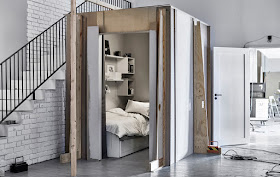A friend of mine recently contacted me to discuss his accommodation plans. Local zoning laws allow him to build a structure of ten square metres so we soon got onto the subject of optimizing compact living spaces. This topic has applications in many other fields, including survival so I thought I would blog some of our thoughts.
Firstly, make the best use of light. Pretentious interior designers on house makeover shows disparage marigold-painted walls. There are good reasons why marigold is so commonly chosen. It is light and it is warm, so a very good colour for living space walls. My own walls are a cream colour that works well with white trim and furnishings. If you have to live in a small space chose light and warm colours, not just for your walls but the other items that surround you.
Personally I never use curtains. If you do make sure the rail is wider than the window. This allows you to fully expose the window when the curtains are drawn, maximising the light entering your compact space.
Intelligent use of mirrors can increase the light and illusion of space. Shop around since large mirrors can be expensive. Mirror tiles, on the other hand can be quite reasonable.
Compact living requires efficient use of space. Most caravans have seating areas that convert to beds at night. The table between the seats forms the centre part of the bed and the cushions become the mattress. This has some advantages. Unlike a conventional mattress the cushions can be easily taken outside to sun or air. Beat them with a carpet beater to get the dust out.
In all the caravans I have slept in the tables have been one-legged affairs that engaged a rail on the wall. A more conventional table with folding legs may be a better choice for our compact living space. This allows the table to be taken outside if the weather is nice. Ideally the legs would be an inverted “T” shape so you can easily take your seat. The table is your dining area and desk. At night it is part of your bed. When not needed it folds up and can be placed out of the way.
The lower part of the seats are also storage boxes. Logically this would be a good place to store your bedding. Install some vent panels so the bedding can air and dry during the day.
For bedding use rectangular sleeping bags or duvets. Sleep on one and under another. Have a light blanket, duvet or bag for summer nights and as additional insulation when it is really cold. Air your bedding outside regularly.
I discussed alternate sleeping systems such as hammocks and cots with my friend and these may be the subjects of future blogs. The caravan-style convertible sleeping/ seating area seems the most practical choice for this application.
Above is a rather nice example of a compact living area from an IKEA site. It could be improved by replacing the conventional bed with the system described above. I like the laundry bag that fits at the end of the bed. Ideally this bag would also let you carry the laundry to the machine or laundrette.
Storage space is an important consideration of a compact living area. Unlike a typical caravan you may be living in this area for months or years at a time. The IKEA photo shows most of one wall used for storage areas. These should be as tall as possible. If they do not reach the ceiling it should be practical to use their tops for additional storage.
Conventional wardrobes have doors that swing out into your limited living space. The above arrangement uses a rail mounted in a storage unit to hang jackets and trousers. Obviously the unit needed must be about half a metre deep. If you do not like your clothing out in the open like this or fear some items might get faded by the sun fit this section with a light-coloured curtain.
Even if your storage units are free-standing it is prudent to attach them to the walls to “earthquake-proof” them. Open fronted shelving units create a feeling of space and make it easier to find things. Transparent boxes are useful here too. If your compact living area is mobile your storage areas will need doors. Sliding doors are worth considering. Shelves should be detachable so height and arrangement can be changed easily to suit the contents.
Other areas can also be used for additional storage area. The areas under the seating have already been mentioned. Shelves can be mounted above the seating/ sleeping area but must be high enough that you do not hit your head on them when you stand. Very tall visitors will need watching! If you want a bedside table make it a short shelving unit. If you have room for a free-standing chair have one that folds up when not needed. A stout storage box with a cushion on is a stool. Without the cushion it can help reach those high shelves.
The Books








